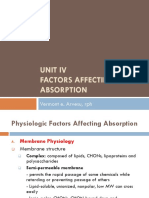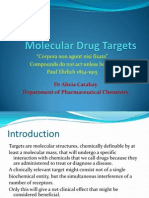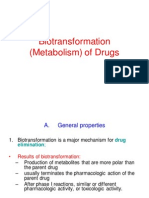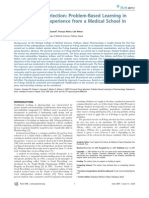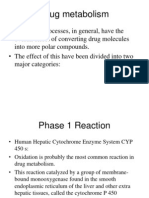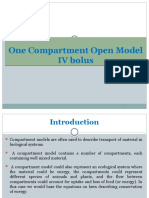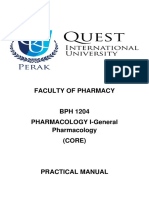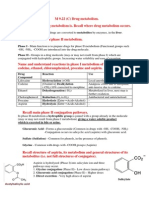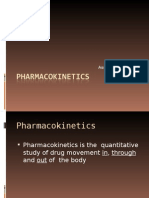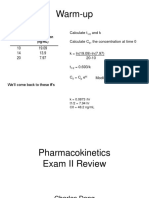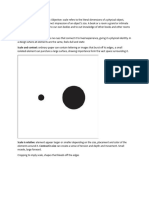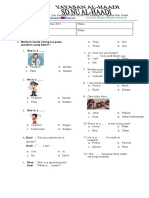A. Principles of Drug Metabolism
A. Principles of Drug Metabolism
Uploaded by
Lynette EvangelistaCopyright:
Available Formats
A. Principles of Drug Metabolism
A. Principles of Drug Metabolism
Uploaded by
Lynette EvangelistaOriginal Title
Copyright
Available Formats
Share this document
Did you find this document useful?
Is this content inappropriate?
Copyright:
Available Formats
A. Principles of Drug Metabolism
A. Principles of Drug Metabolism
Uploaded by
Lynette EvangelistaCopyright:
Available Formats
Saint Louis University | Department of Pharmacy
Pharm 222: Pharmaceutical and Medicinal Organic Chemistry (Lecture)
Pharm 222: Pharmaceutical and Medicinal Organic Chemistry
Chapter III: Drug Metabolism (Part I)
Topics:
A. Principles of Drug Metabolism
B. First- Pass Effect
C. Consequences of Metabolism
D. Sites of Metabolism/Drug Biotransformation
E. Cytochrome P-450
F. Enzyme Inhibition and Enzyme Induction
A. Principles of Drug Metabolism
Most organic compounds (drugs and xenobiotics) entering the body are relatively
lipid soluble (lipophilic). To be absorbed, they must traverse the lipoprotein
membranes of the lumen walls of the GIT.
Then, once in the bloodstream, these molecules can diffuse passively through other
membranes and be distributed effectively to reach various target organs to exert their
pharmacological actions.
• If lipophilic drugs were not metabolized to polar, readily excretable water-
soluble products, they would remain indefinitely in the body, eliciting their
biological effects. (lipophilic drugs undergo tubular reabsorption and thus are not excreted through the urine)
• Xenobiotics then meet their metabolic fate through various enzyme systems that change the parent compound to
render it more water soluble (hydrophilic). Once the metabolite is sufficiently water soluble, it may be excreted from
the body.
Thus, the formation of water-soluble metabolites not only enhances drug elimination, but also leads to compounds that
are generally pharmacologically inactive and relatively nontoxic.
Main Purpose of Metabolism: conversion of drugs into polar, water soluble products that are readily excretable
B. First Pass Effect
- Happens when an orally administered drug is absorbed into bloodstream through GIT passes through the liver
before being further distributed
- Examples:
Isoproterenol
Pentazocine
Lidocaine
Propoxyphene
Meperidine
Propranolol
Morphine
Salicylamide
Nitroglycerin
Intestinal mucosa
- Contains CYP3A4 isozyme and P-glycoprotein (PGP) that can
capture drug and secrete it back to intestinal tract
- Plays a role in extra hepatic metabolism of xenobiotics
- Example: Isoproterenol (sulfate conjugation); aromatic azo and nitro
drugs (bacterial flora)
Prepared by: Aldrex B. Dacawe, RPh, MS Pharm
Lectured by: Mary Christine S. Cariño, RPh, MS Pharm Page 1 of 4
Saint Louis University | Department of Pharmacy
Pharm 222: Pharmaceutical and Medicinal Organic Chemistry (Lecture)
C. Consequences of Metabolism:
A. May yield inactive metabolites
- Some metabolites are inactive meaning their pharmacologically active parent compounds become inactivated/
detoxified.
- Examples:
1. Hydrolysis of procaine to p- aminobenzoic acid & diethylethanolamine
2. Oxidation of 6- mercaptopurine to 6- mercapturic acid
B. May retain similar activity
- Certain metabolites retain pharmacological activity of their parent compounds to greater or lesser degree.
- Examples:
1. Imipramine is demethylated to the essentially equiactive antidepressant, desipramine
2. Acetohexamide is reduced to the more active hypoglycemic, I- hydroxyhexamide
3. Codeine is demethylated to the more active analgesic, morphine
C. May produce metabolites with altered activity
- Some metabolites develop activity which is different from that of their parent compound.
- Examples:
1. The antidepressant iproniazid is dealkylated to the antitubercular drug, Isoniazid
2. The vitamin retinoic acid (Vitamin A) is isomerized to the anti- acne agent, isoretinoic acid
D. Production of bioactivated metabolites
- Some pharmacologically inactive parent compounds are converted to active compounds within the body. These
parent compounds are known as prodrugs.
- Example:
1. The prodrug enalapril is hydrolyzed to enalaprilat
2. The prodrug sulindac, a sulfoxide, is reduced to the active sulfide
3. The antiparkinsonian levodopa (L- dopa) is decarboxylated in the neuron to the active dopamine.
D. Sites of Metabolism/ Drug Biotransformation
Liver
- The enzymes involved in metabolism are present in
many tissues but generally are more concentrated
in the liver
- Enzymes located in the endoplasmic reticulum of
liver cells protect the organism against an
accumulation of lipid-soluble exogenous and
endogenous compounds by converting them to
water-soluble metabolites which can be easily
excreted by the kidney
- Cytochrome P450 enzyme species (eg, CYP2D6
and CYP3A4) that are responsible for much of drug
metabolism. Many isoforms of CYP have been
recognized
Prepared by: Aldrex B. Dacawe, RPh, MS Pharm
Lectured by: Mary Christine S. Cariño, RPh, MS Pharm Page 2 of 4
Saint Louis University | Department of Pharmacy
Pharm 222: Pharmaceutical and Medicinal Organic Chemistry (Lecture)
Extrahepatic Metabolism
- Refers to drug biotransformation/ metabolism that takes place in tissues other than the liver
- The most common sites include the portals of entry & exit of excretion
- The extrahepatic sites are as follows:
1. Plasma
- Contains esterase enzymes which is responsible primarily for the hydrolysis of esters
- Example: Simple esters (procaine, succinylcholine)
- Additionally, plasma esterases can activate a variety of prodrugs
2. Intestinal mucosa
- Lipid- soluble drug passes through the intestinal mucosa
- Metabolized before entering the blood
- The result is comparable to first- pass effect
3. Intestinal bacterial flora
- Secrete a number of enzymes capable of metabolizing drugs & other xenobiotics
- Any factor that modifies the intestinal flora may also modify drug activity
- Intestinal bacterial flora secrete beta- glucuronidase enzyme
- Certain bacterial flora convert vitamin precursor to their active forms
- Bacterial flora can also convert certain substances to their toxic forms
- Intestinal flora produce azoreductase enzyme
4. Stomach
- Has acidic environment
- This acidic environment produces non- enzymatic degradation of some drug molecules
- Gastric acid assists in the degradation of CHONs & peptides
5. Nasal mucosa
- Provides a high level of CYP450
- Nasal decongestants, anesthetics, nicotine, cocaine
E. Cytochrome P450
- Cytochrome P450 (CYP450) enzymes are essential for the production of cholesterol, steroids, prostacyclins, and
thromboxane A2.
- They are mixed function oxidases that catalyze the vast majority of oxidation reactions
- They also are necessary for the detoxification of foreign chemicals and the metabolism of drugs.
- CYP450 enzymes are so named because they are bound to membranes within a cell (cyto) and contain a heme
pigment (chrome and P) that absorbs light at a wavelength of 450 nm when exposed to carbon monoxide.
- There are more than 50 CYP450 enzymes, but the CYP1A2, CYP2C9, CYP2C19, CYP2D6, CYP3A4, and CYP3A5
enzymes metabolize 90 percent of drugs.
- These enzymes are predominantly expressed in the liver, but they also occur in the small intestine (reducing drug
bioavailability), lungs, placenta, and kidneys.
Prepared by: Aldrex B. Dacawe, RPh, MS Pharm
Lectured by: Mary Christine S. Cariño, RPh, MS Pharm Page 3 of 4
Saint Louis University | Department of Pharmacy
Pharm 222: Pharmaceutical and Medicinal Organic Chemistry (Lecture)
F. Enzyme Inhibition and Enzyme Induction
This is a type of drug interaction which occurs when two or more drugs are administered simultaneously.
The state of enzymatic systems involved in drug biotransformation represents an important factor in
pharmacokinetic and/ or pharmacodynamic variability. The changes in the state of enzymes for metabolism of
drugs may be qualitative and quantitative.
Qualitative changes are commonly due to impairments in the state of the enzymatic systems. Quantitative
changes may evolve in two directions: either (1) the stimulation of enzymatic activity (enzyme induction) or (2)
the reverse, a reduction in enzyme activity (enzyme inhibition).
• Precipitant Drug- the drug that causes change
• Object drug- the drug that undergoes change
Enzyme Inhibition
- The precipitant drug inhibits enzymes for object drug and so the object drug’s metabolism becomes slow.
- Example: Cimetidine + Theophylline
Enzyme Induction
- The precipitant drug induces enzymes responsible the metabolism of object drug and so the object drug’s
metabolism becomes fast.
- Example: Phenobarbital + Amoxicillin
Enzyme Inducers Enzyme Inhibitors
Phenobarbital
Metronidazole
Phenytoin
Erythromycin
Rifampicin
Disulfiram
Carbamazepine
Isoniazid
Chronic Alcohol Use
Cimetidine
Cigarette Smoking Ketoconazole
Acute Alcohol Use
Valproic acid
Grapefruit Juice
Omeprazole
Fluoroquinolones
End of lecture. Thank you for listening.
“Even if you started weak, try your hardest to finish strong.” -Dacawe, 2020
Prepared by: Aldrex B. Dacawe, RPh, MS Pharm
Lectured by: Mary Christine S. Cariño, RPh, MS Pharm Page 4 of 4
You might also like
- Emily DickinsonDocument278 pagesEmily DickinsonCandelaria GrisafiNo ratings yet
- Ride The Cyclone Study Guide WebDocument6 pagesRide The Cyclone Study Guide Webgdfr bgfhd0% (1)
- 9autacoids 14010v9023022 Phpapp02Document109 pages9autacoids 14010v9023022 Phpapp02h3cn1r3100% (1)
- Acetylcholine Stimulates Muscle Contraction in Guinea Pig Ileum and Atropine Diminishes The Extent of ContractionDocument2 pagesAcetylcholine Stimulates Muscle Contraction in Guinea Pig Ileum and Atropine Diminishes The Extent of Contractionleh.mo931580% (5)
- Orgemd Post Lab Activity 2 4Document43 pagesOrgemd Post Lab Activity 2 4Lynette Evangelista100% (3)
- Wild Boy by Rob Lloyd Jones Sample ChapterDocument31 pagesWild Boy by Rob Lloyd Jones Sample ChapterWalker Books100% (3)
- Factors Affecting Distribution of DrugDocument35 pagesFactors Affecting Distribution of DrugShubhrajit MantryNo ratings yet
- Phase-I Drug MetabolismDocument48 pagesPhase-I Drug MetabolismPhoebe LlameloNo ratings yet
- ChronopharmacokineticsDocument38 pagesChronopharmacokineticsvaibhav5414No ratings yet
- Excretion of DrugDocument36 pagesExcretion of DrugYeni SuwitaNo ratings yet
- Protein Binding of DrugDocument22 pagesProtein Binding of DrugManikanta GupthaNo ratings yet
- Unit 4 Factors Affecting Drug AbsorptionDocument53 pagesUnit 4 Factors Affecting Drug Absorptiondiadiaida100% (1)
- Molecular Drug Targets-1Document75 pagesMolecular Drug Targets-1Phoebe Llamelo100% (1)
- Drug Metabolism and Drug InteractionsDocument52 pagesDrug Metabolism and Drug InteractionsMarc Imhotep Cray, M.D.100% (1)
- Medicinal Chemistry Unit III Cholenergic Anti ChokenergicDocument32 pagesMedicinal Chemistry Unit III Cholenergic Anti ChokenergicjalilaNo ratings yet
- Chapter - 2 Rational Drug Use: Health Administrator Vol: XIX Number 1: 5-7Document3 pagesChapter - 2 Rational Drug Use: Health Administrator Vol: XIX Number 1: 5-7mayapuspitasariunsriNo ratings yet
- Lead Identification and Lead Optimization: An Over View of Modern Drug Discovery ProcessDocument21 pagesLead Identification and Lead Optimization: An Over View of Modern Drug Discovery ProcessTia Rahayu AnggrainiNo ratings yet
- So 2Document16 pagesSo 2Safrina SabatiniNo ratings yet
- Topics: CLASS No. - 1 (B. Pharm. 4 Sem, Pharmacology) by Dr. Habibur RahmanDocument4 pagesTopics: CLASS No. - 1 (B. Pharm. 4 Sem, Pharmacology) by Dr. Habibur RahmanHabibur RahmanNo ratings yet
- Pharma Laboratory ExperimentsDocument34 pagesPharma Laboratory Experimentsapi-3748748100% (4)
- PharmacodynamicsDocument40 pagesPharmacodynamicsheba1997bshNo ratings yet
- Biotransformation of DrugsDocument22 pagesBiotransformation of DrugsZaigham Hammad100% (1)
- Flavanoids, L 3Document48 pagesFlavanoids, L 3Ammadazfar ImamNo ratings yet
- Workbook 2016 StomDocument186 pagesWorkbook 2016 StomAysenNo ratings yet
- Drug DistributionDocument49 pagesDrug DistributionDrAmit VermaNo ratings yet
- Lecture 2 Introductiion 2022Document23 pagesLecture 2 Introductiion 2022Ahmed HamarnehNo ratings yet
- Drug DistributionDocument49 pagesDrug DistributionRinta Moon100% (1)
- Pharmaceutical Inorganic ChemistryDocument20 pagesPharmaceutical Inorganic ChemistryMoses DumbuyaNo ratings yet
- Personal Drug Selection: Problem-Based Learning in Pharmacology: Experience From A Medical School in NepalDocument5 pagesPersonal Drug Selection: Problem-Based Learning in Pharmacology: Experience From A Medical School in NepalPLoSNo ratings yet
- PHARM4515 8 (Antihistamines)Document45 pagesPHARM4515 8 (Antihistamines)Street Pasutri RolferNo ratings yet
- OTC wv1Document42 pagesOTC wv1Sheena GagarinNo ratings yet
- 1 - Pharmaceutical Care Practice - An OverviewDocument76 pages1 - Pharmaceutical Care Practice - An Overviewekram100% (1)
- Lesson 2 Pharmacist Role in HTADocument6 pagesLesson 2 Pharmacist Role in HTAJewell M. LicupNo ratings yet
- Chapt-7 Structure Activity Relationships - OKDocument35 pagesChapt-7 Structure Activity Relationships - OKSaifuddin AzizNo ratings yet
- Pharmaceutical Chemistry Chapter 11 Important QuestionsDocument7 pagesPharmaceutical Chemistry Chapter 11 Important QuestionsMahesh Kokne100% (1)
- Drug Metabolite-Reaction and ConjugationDocument51 pagesDrug Metabolite-Reaction and Conjugationnasibdin100% (1)
- 2.one Compartment Open ModelDocument90 pages2.one Compartment Open ModelBLESSY SARA KURIANNo ratings yet
- BPharma-6Sem-DrRishiPaliwal-Biopharmaceutics & PharmacokineticsDocument23 pagesBPharma-6Sem-DrRishiPaliwal-Biopharmaceutics & Pharmacokineticsירדן לויןNo ratings yet
- Drug MetabolismDocument78 pagesDrug Metabolismjuz gonzagaNo ratings yet
- Alkaloids1 160215123735Document35 pagesAlkaloids1 160215123735Daiene Paula100% (1)
- Antipsychotics and Their SarsDocument3 pagesAntipsychotics and Their SarsJarein Mae CirunayNo ratings yet
- Transes PharmacodynamicsDocument36 pagesTranses PharmacodynamicsGwyneth Koleen Lopez100% (1)
- Introduction To PharmacognosyDocument12 pagesIntroduction To PharmacognosyReyes MesshaelNo ratings yet
- Bpharm Sem 6 Medicinal Chemistry Ques PaperDocument3 pagesBpharm Sem 6 Medicinal Chemistry Ques PaperNavam KumarNo ratings yet
- MCQs 01-01 Introduction To Basic Principal of PharmacologyDocument146 pagesMCQs 01-01 Introduction To Basic Principal of PharmacologyNomi Waqas GulNo ratings yet
- Pharmacokinetics Review CEE With Practice ProblemsDocument148 pagesPharmacokinetics Review CEE With Practice ProblemsBenhur Leithold Lapitan100% (1)
- Domain 2 Public Health AnnotationsDocument9 pagesDomain 2 Public Health AnnotationsjkdanielesNo ratings yet
- Chemistry of FlavonoidsDocument15 pagesChemistry of FlavonoidsSathish SizzyNo ratings yet
- Pharmacology Practical Manual - Student Copy2Document11 pagesPharmacology Practical Manual - Student Copy2NareshNo ratings yet
- Medicinal Chemistry of Beta-Lactam AntibioticsDocument13 pagesMedicinal Chemistry of Beta-Lactam AntibioticsJosiah O OmobaNo ratings yet
- Pharmacology: Outline PharmacodynamicsDocument11 pagesPharmacology: Outline PharmacodynamicsAlloiBialbaNo ratings yet
- Appendix B. Medication Therapy Problem Categories FrameworkDocument1 pageAppendix B. Medication Therapy Problem Categories FrameworksydenyNo ratings yet
- Prodrug Delivery PDFDocument6 pagesProdrug Delivery PDFanantachoudhuryNo ratings yet
- M9.22 - Drug MetabolismDocument2 pagesM9.22 - Drug MetabolismKristin Douglas100% (1)
- 1important DefinitionsDocument3 pages1important DefinitionsBest VideoNo ratings yet
- Physicochemical Properties in Relation To Biological ActivityDocument11 pagesPhysicochemical Properties in Relation To Biological Activityjemms16No ratings yet
- Pharmacokinetics AbsorptionDocument27 pagesPharmacokinetics AbsorptionchondroboraNo ratings yet
- Pharmacy Orientation PPP211: Introduction To The Pharmacy Profession and The Future of The PharmacistDocument27 pagesPharmacy Orientation PPP211: Introduction To The Pharmacy Profession and The Future of The PharmacistJape GarridoNo ratings yet
- Drug Elimination and Hepatic ClearanceDocument7 pagesDrug Elimination and Hepatic ClearanceMary Angelique BanogonNo ratings yet
- Unit I General PharmacologyDocument16 pagesUnit I General PharmacologycuolyNo ratings yet
- Kinetics Review 2Document37 pagesKinetics Review 2filenotfoundNo ratings yet
- Communication Skills in Pharmacy Practice: Dr. Hiwak. SaaedDocument70 pagesCommunication Skills in Pharmacy Practice: Dr. Hiwak. SaaedAnonymous whcvnPBeQNo ratings yet
- Informatics 2Document39 pagesInformatics 2Lynette EvangelistaNo ratings yet
- Unit I: Introduction To Pharmacy InformaticsDocument24 pagesUnit I: Introduction To Pharmacy InformaticsLynette Evangelista100% (1)
- Chemical Formula Synonyms Preparation: Experiment 1 - Hydrogen PeroxideDocument10 pagesChemical Formula Synonyms Preparation: Experiment 1 - Hydrogen PeroxideLynette EvangelistaNo ratings yet
- InformaticsDocument28 pagesInformaticsLynette EvangelistaNo ratings yet
- Hemodynamic Monitoring SystemsDocument1 pageHemodynamic Monitoring SystemsutuniversechannelNo ratings yet
- Febrile Convulsion1Document29 pagesFebrile Convulsion1Gideon AdurojaNo ratings yet
- Electronics Experimenters Handbook 1995 SummerDocument116 pagesElectronics Experimenters Handbook 1995 SummerBenjamin Dover100% (1)
- Specification Tender No 2122020001 AT1OBiiDocument441 pagesSpecification Tender No 2122020001 AT1OBiiMahendra KumarNo ratings yet
- Use of Linear Programming For Optimal Production in A Production Line in Coca - Cola Bottling Company, IlorinDocument43 pagesUse of Linear Programming For Optimal Production in A Production Line in Coca - Cola Bottling Company, IlorinTejas GosaviNo ratings yet
- Solution Manual For Fundamental of ElectronicsDocument3 pagesSolution Manual For Fundamental of ElectronicsTalha ImranNo ratings yet
- Satish Naik 2017 PDFDocument2 pagesSatish Naik 2017 PDFSktiNo ratings yet
- 07 Perfomance Apprical NewDocument87 pages07 Perfomance Apprical NewMichael WellsNo ratings yet
- LuptonDocument7 pagesLuptonsarabrown2311No ratings yet
- Assessment Task Title: Short Answer Questions and Case Study Assessment Conditions: The Questions Can Be Completed in Own TimeDocument4 pagesAssessment Task Title: Short Answer Questions and Case Study Assessment Conditions: The Questions Can Be Completed in Own TimeGabrielNo ratings yet
- Beam DetailsDocument14 pagesBeam DetailsAbdul AzeemNo ratings yet
- II bcom-LABPROGRAMSDocument42 pagesII bcom-LABPROGRAMSecommercejvsNo ratings yet
- Baphomet 1Document2 pagesBaphomet 1AtazothnashaasNo ratings yet
- WIFA Template 2017 Forms 1 To 3Document13 pagesWIFA Template 2017 Forms 1 To 3Klang TorresNo ratings yet
- Lesson 1 - Module 1 - Circulatory SystemDocument27 pagesLesson 1 - Module 1 - Circulatory SystemPapiNo ratings yet
- For Roman Ingarden Nine Essays in Phenomenology (Anna-Teresa Tymieniecka (Ed.) )Document183 pagesFor Roman Ingarden Nine Essays in Phenomenology (Anna-Teresa Tymieniecka (Ed.) )jenny w100% (1)
- (Onkyo) - TX-SR604E Service Manual (Software Manual) (Parts Catalog) (Quick Start) (User Guide) (Circuit Diagrams)Document203 pages(Onkyo) - TX-SR604E Service Manual (Software Manual) (Parts Catalog) (Quick Start) (User Guide) (Circuit Diagrams)Daro K.No ratings yet
- Soal PAT Kelas 4 - Bahasa InggrisDocument4 pagesSoal PAT Kelas 4 - Bahasa InggrisSULIH KARUNIAWATI100% (2)
- Copy of RecipeDocument2 pagesCopy of Recipeapi-614051527No ratings yet
- Amnesia With Focus On Post Traumatic AmnesiaDocument27 pagesAmnesia With Focus On Post Traumatic AmnesiaWilliam ClemmonsNo ratings yet
- SV Weekly Report Small Section Sat-Sat 07-04-2024 (Recovered) FinalDocument43 pagesSV Weekly Report Small Section Sat-Sat 07-04-2024 (Recovered) FinalBadiea MudhshNo ratings yet
- OSHO® Chakra Sounds Meditation™ PDFDocument2 pagesOSHO® Chakra Sounds Meditation™ PDFSurinder VermaNo ratings yet
- 3288 Parts PDFDocument26 pages3288 Parts PDFKadir Koray BozyelNo ratings yet
- Idealtech PricelistDocument5 pagesIdealtech PricelistNeverson RusipinNo ratings yet
- Autodyn 14.0 Ws01 Filled Can CrushDocument21 pagesAutodyn 14.0 Ws01 Filled Can CrushMarcel CondurNo ratings yet
- Ccnpv7.1 Switch Lab5-1 Ivl-Routing StudentDocument10 pagesCcnpv7.1 Switch Lab5-1 Ivl-Routing StudentCristianFelipeSolarteOrozcoNo ratings yet
- Handbook of Materials SelectionDocument10 pagesHandbook of Materials SelectionMarco AucancelaNo ratings yet











